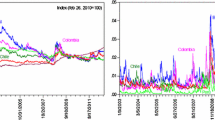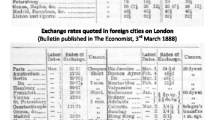Abstract
This paper examines the impact of payment technology on seasonality in currency in circulation. We specify that total transaction in a period follows a Gompertz distribution over time and extend the standard Baumol–Tobin model to obtain a nonlinear expression of currency growth. In contrast to linear dummy variable models that reflect fixed seasonality, our theoretical results reflect gradually decaying seasonal coefficients over time and suggest that in the long-run, growth-in currency holdings would not be seasonal but would be affected by interest rate shocks only. Empirical applications of the model for the USA and India reveal its superior performance compared to linear dummy variable models with fixed seasonality.




Similar content being viewed by others
Notes
In India, the total stock of currency increased by Rs. 1229.2 billion between the financial years 2011–2012 and 2012–2013. Expenditure incurred on security printing (note forms) during 2012–2013 (July–June) was Rs. 28.72 billion (RBI Annual Report, 2012–2013, p. 126). Thus, RBI spent about 2.34 % of every Rupee for its production. The same expenditure was 0.05 % of Indian GDP in 2012–2013.
For example, in the obtained functional form of Baumol (1952), currency is positively related to the square roots of transaction need and the cost for such a transaction and is negatively related to the square root of interest rate that proxies the opportunity cost of holding currency.
See Tilley (1992) for detailed discussion on lognormal interest rate as a stochastic process.
In a stinging criticism, Kirman (1992) calls the assumption of a representative agent ‘fatally flawed’ (p. 132).
For example, the often cited study of Hall (1978) in the context of consumption function assumed a representative agent framework.
For instance Cabrero and de España (2002) modelled and forecasted the daily currency in circulation forecasting results for Euro area by using two major approaches, i.e. the ARIMA based approach and structural time series (STS) approach. They conclude that the best forecasting model is a combination of the ARIMA and STS models. The reason for this is argued by the fact that certain seasonal patterns may not be completely captured by a linear structure.
Note that zero currency growth does not imply zero currency holdings. It only implies a stable level of currency holding as long as interest rates are unchanging.
Though \(D_t\) and \(M_t\) are discrete variables. We define \(D_t^*\) and \(M_t^*\), where \(D_t^*\) is a continuous variables in Akaike (1974) and Reddy (1998) and \(M_t^*\) is continuous in Akaike (1974) and Cassino et al. (1997). We also define \(h^*(D_t^*,M_t^*,F_t) \). One may approximate \(h^*(D_t^*,M_t^*,F_t)\) with respect to \(D^{*}\) and \(M^{*}\). It may be noted that the values of the \(h^*(D_t^*,M_t^*,F_t)\) for integer values of \(D^{*}\) and \(M^{*}\) would closely correspond to similar h() values.
The financial year in the USA and India starts with \(1\mathrm{st}\) October and \(1\mathrm{st}\) April respectively.
We also tried to capture the impact of Easter along with its lags and leads but the coefficient were found to be insignificant.
The values of \(e^{-b*t}\) for the USA and India are calculated as 0.9992 and 0.9994 when \(t=1\) and 0.1950 and 0.2950 when \(t=1981\) respectively.
For brevity, we are not reporting the ACF and PACF of residuals. It can be made available on request.
Currency substitution occurs when the residents of a currency use a foreign currency in parallel to or instead of the domestic currency (Feige 2011). The USA dollar is one of the currency used as a substitute worldwide officially and unofficially equally (Baliño et al. 1999; Bogetic 2000). For detailed discussion on the use of USA dollar as a currency substitution abroad see Hellerstein and Ryan (2011).
References
Akaike, H. 1974. A new look at the statistical model identification. IEEE Transactions on Automatic Control 19(6): 716–723. doi:10.1109/TAC.1974.1100705.
Almon, S. 1965. The distributed lag between capital appropriations and expenditures. Econometrica 33(1): 178–196. doi:10.2307/1911894.
Auerbach, I. 1964. Forecasting currency in circulation. In Essays in Money and Credit, 13–18. New York: Federal Reserve Bank of New York.
Baliño, T.J., A., Bennett, and E. Borensztein. 1999. Monetary policy in dollarized economies, vol. 171. International Monetary Fund.
BASS, F.M. 1969. A new product growth for model consumer durables*. Management Science, 15(5). http://perso.univ-rennes1.fr/raphael.suire/Bass1969.pdf. Accessed 15 June 2014.
Baumol, W.J. 1952. The transactions demand for cash: an inventory theoretic approach. The Quarterly Journal of Economics 66(4): 545–556.
Bhattacharya, K., and H. Joshi. 2001. Modelling currency in circulation in India. Applied Economics Letters 8(9): 585–592.
Bhattacharya, K., and H. Joshi. 2002. An Almon approximation of the day of the month effect in currency in circulation. Indian Economic Review 37(2): 163–174.
Bogetic, Z. 2000. Official dollarization: current experiences and issues (SSRN Scholarly Paper No. ID 1809824). Rochester, NY: Social Science Research Network. http://papers.ssrn.com/abstract=1809824. Accessed 15 June 2014.
Cabrero, A., and B. de España. (2002). Modelling the daily banknotes in circulation in the context of the liquidity management of the European Central Bank. European Central Bank. http://www.suomenpankki.fi/pdf/104809.pdf. Accessed 7 Aug 2015.
Canova, F., and E. Ghysels. 1994. Changes in seasonal patterns: are they cyclical? Journal of Economic Dynamics and Control 18(6): 1143–1171.
Cassino, V., P. Misich, and J. Barry. 1997. Forecasting the demand for currency. Reserve Bank of New Zealand Bulletin 60. https://ideas.repec.org/a/nzb/nzbbul/march19973.html. Accessed 14 June 2014.
Dotsey, M. 1988. The demand for currency in the United States. Journal of Money, Credit and Banking 20(1): 22–40. doi:10.2307/1992665.
Feige, E.L. 2011. New estimates of US currency abroad, the domestic money supply and the unreported economy. Crime, Law and Social Change 57(3): 239–263. doi:10.1007/s10611-011-9348-8.
Haessel, W. 1978. Measuring goodness of fit in linear and nonlinear models. Southern Economic Journal 44(3): 648–652. doi:10.2307/1057220.
Hall, R. 1978. Stochastic implications of the life cycle-permanent income hypothesis: theory and evidence. Journal of Political Economy 86(6): 971–987.
Harvey, A., S.J. Koopman, and M. Riani. 1997. The modeling and seasonal adjustment of weekly observations. Journal of Business and Economic Statistics 15(3): 354–368.
Hellerstein, R., and W. Ryan. 2011. Cash dollars abroad. Federal Reserve Bank of New York Staff Reports (400). http://newyorkfed.org/research/staff_reports/sr400.pdf. Accessed 14 June 2014.
Hlaváček, M., J. Čada, and F. Hakl. 2005. The application of structured feedforward neural networks to the modelling of the daily series of currency in circulation. In Advances in natural computation. Berlin, Heidelberg: Springer. http://link.springer.com/chapter/10.1007/11539087_163. Accessed 14 June 2014.
Jadhav, N. 1994. Monetary economics for India. Delhi: Macmillan India.
Karni, E. 1973. The transactions demand for cash: incorporation of the value of time into the inventory approach. The Journal of Political Economy 81(5): 1216–1225.
Kirman, A.P. 1992. Whom or what does the representative individual represent? The Journal of Economic Perspectives 6(2): 117–136.
Kohn, D.L. (1976). Currency movements in the United States. Monthly Review. https://m.kansascityfed.com/PUBLICAT/ECONREV/econrevarchive/1976/2q76kohn.pdf. Accessed 14 June 2014.
Li, C. 2007. Essays on the inventory theory of money demand. https://circle.ubc.ca/handle/2429/417. Accessed 14 June 2014.
Lin, C.-F.J., and T. Teräsvirta. 1994. Testing the constancy of regression parameters against continuous structural change. Journal of Econometrics 62(2): 211–228. doi:10.1016/0304-4076(94)90022-1.
Mahajan, V., E. Muller, and F.M. Bass. 1990. New product diffusion models in marketing: a review and directions for research. Journal of Marketing 54(1): 1–26. doi:10.2307/1252170.
Miller, M.H., and D. Orr. 1966. A model of the demand for money by firms. The Quarterly Journal of Economics 80(3): 413–435.
Motulsky, H.J., and L.A. Ransnas. 1987. Fitting curves to data using nonlinear regression: a practical and nonmathematical review. The FASEB Journal 1(5): 365–374.
Nachane, D.M., A.B. Chakraborty, A.K. Mitra, and S. Bordoloi. 2013. Modelling currency demand in India: an empirical study. Reserve Bank of India Discussion Paper 39.
Palanivel, T., and L.R. Klein. 1999. An econometric model for india with emphasis on the monetary sector. The Developing Economies 37(3): 275–327. doi:10.1111/j.1746-1049.1999.tb00235.x.
Reddy, Y.V. 1998. Report of the working group on money supply: analytics and methodology of compilation. Mumbai: Reserve Bank of India.
Schwarz, G. 1978. Estimating the dimension of a model. The Annals of Statistics 6(2): 461–464. doi:10.1214/aos/1176344136.
Tilley, J.A. 1992. An actuarial layman’s guide to building stochastic interest rate generators. Transactions of the Society of Actuaries 44(509): 64.
Tobin, J. 1956. The interest-elasticity of transactions demand for cash. The Review of Economics and Statistics 38(3): 241–247.
Tobin, J. 1958. Liquidity preference as behavior towards risk. The Review of Economic Studies 25(2): 65–86. doi:10.2307/2296205.
Author information
Authors and Affiliations
Corresponding author
Rights and permissions
About this article
Cite this article
Bhattacharya, K., Singh, S.K. Impact of Payment Technology on Seasonality of Currency in Circulation: Evidence from the USA and India. J. Quant. Econ. 14, 117–136 (2016). https://doi.org/10.1007/s40953-015-0024-1
Published:
Issue Date:
DOI: https://doi.org/10.1007/s40953-015-0024-1
Keywords
- Currency in circulation
- Seasonality
- Payment system
- Inventory theory of money
- Baumol–Tobin model
- Gompertz curve




